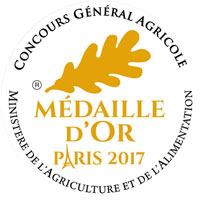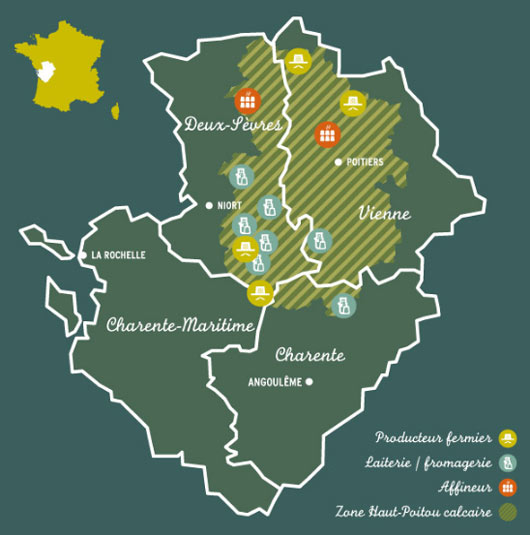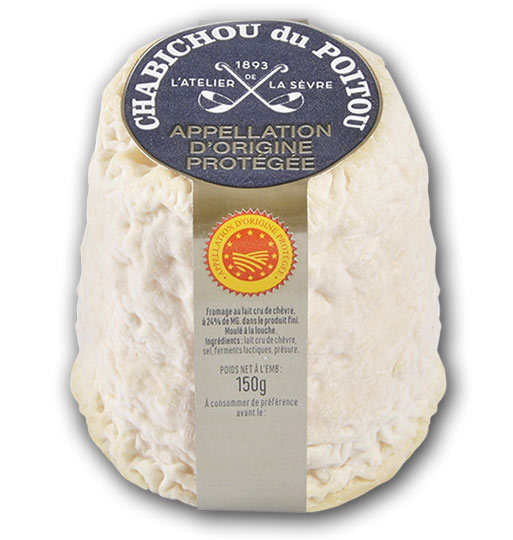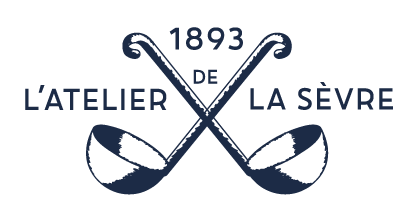Step 1: Milk curdling
The goats milk collected by the Coopérative Laitière de la Sèvre is used raw, with the addition of milk enzymes and a light amount of pressure in order to let the milk set slowly.
Step 2: Ladle moulding
The curd is removed and then placed into moulds which give the cheese its shape.
Step 3: Cheese draining
Draining the cheese allows us to extract the small amount of milk contained within the curds; it is a very important step as it ensures that the cheese is properly conserved. To do this, the moulds which the curds are placed in are perforated to allow the cheese to naturally drain without any pressure.
Step 4: Dry salting
The salting process is essential to bring out the flavours of the cheese.
Step 5: Maturing
Our cheeses are matured for a long time in a drying room to allow all of the flavours to really come out. Our cheeses are regularly turned by the master cheesemaker.
Step 6: Packaging in wooden crates
Once the products are matured, they are then sent to the packaging room to be placed into wooden crates with wicker, a type of straw which allows the cheese to aerate.

Our medals
Our Montcoudray was awarded the Médaille d’Or at the 2017 Concours Général Agricole.
This cows milk cheese takes its name from the Coudray-Salbart situated on a hill in the town of Echiré. Its texture and taste will take you by surprise. You can find it, and our whole Atelier de la Sèvre range, at your local dairy stockist.

Our designations
What is an Appellation d’Origine Protégée?
Appellation d’Origine Protégée (AOP), previously known as Appellation d’Origine Contrôlée (AOC), was created in Europe in 1990. It refers to a product which has gained a certain notoriety, made in a defined geographical area and made according to traditional and well-known expertise.
The products are inseparable from their regions and cannot be produced in other areas. The production must take place in that specific region, according to detailed rules and regulations. The latter of which, being sufficiently comprehensive, guarantees the quality and taste of these AOP products for consumers.
The Chabichou du Poitou AOP has enjoyed AOP status since 1996. The producer must adhere to the specific regulations for this cheese. The milk production and the maturing of the cheese must take place within the geographical area of the AOP, which broadly corresponds to the limestone areas of Haut-Poitou, extending across half of Deux-Sèvres and Vienne, as well as certain communes in the north of Charente.



Our Chabichou du Poitou AOP Atelier de la Sèvre (150g) is a raw milk goats cheese.
It owes its shape to the piece of wood used to close wine barrels in years gone by. According to legend, its name dates back to the 8th Century when the Sarrasins were defeated after the Battle of Poitiers. When some of them settled in the region with their flocks of goats, they produced a cheese called Cheblis (goat in Arabic) and this would later become Chabichou.
We are proud of our Chabichou du Poitou Atelier de la Sèvre which often receives gold medals at competitions.
HIRE US RIGHT NOW!
+1(777)123-45-67 / info@freeman.com
Stay In Touch
+1 (132) 123-456-7890 | hello@website.com
[contact-form-7 404 "Not Found"]


